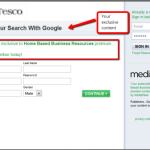E-commerce is the selling of products and services on the internet. This can be achieved by setting up a website that contains tangible or intangible products/services. The concept behind e-commerce is actually quite simple; however, understanding how to correctly execute the establishment of a solid business can be a real challenge. In this article we will explore the different steps that should be undertaken, and additional information that could help you and your fledgling business into the market with which you want to dominate.
Step One: Find Your Niche
Before you even consider setting up your website, you need to consider what you’d like to sell. This is the most important part of the process of setting up an e-commerce website. This is because the products or services you will be selling needs to be good, and they also need to have a high sales potential. However, it is also important to find a product or shop type that isn’t too heavily saturated, or you will not be able to compete with other online shops that have been around for a long time and are market leaders. In step 4 we will talk about how to source products, stock and ship them.
Step Two: The Website
While having a good product or service is important, the website where you’ll be selling is also important. Having a website built from scratch is not a good idea if your budget is small, so try to find a company that provides a hosted e-commerce software package. There are quite a few providers on the web that allow you to set-up low cost websites that also incorporate the premise of e-commerce; they allow you to create a slick design without the need for any design skills. Be sure to check that you can edit the websites code, as this will prove beneficial when your company grows and you can afford to have a designer build a customized look and feel for your business. It is important that you are able to edit your own website to change simple things, such as your widgets, add additional elements, edit your logo, etc. Some of these you can do on your own as there are countless hacks, tips, photoshop logo tutorials, website development tutorials, and more vailable out there.
Your website should have sections for your products, pictures of your products and an easy way to pay for them. It should also have a clean design, some information about what you sell on the front page and a way for customers to easily contact you. Some websites like to include other pages such as a news page, terms and conditions pages and site maps. It is recommended by Google to have pages with good, rich and informative content as it is useful for SEO, which stands for search engine optimization. Search engine optimization is the placement of a website in search engines such as Google, Bing, Yahoo and Ask.
Step Three: Sole Trader, Ltd or PLC?
It is important to consider whether you need to register your company as an actual business. There are various benefits for each type of business and there are about 4-5 types of registration, but to make things simply I’ll roughly skim over the main three. Being a sole trader means you do not have a registered business. This does not means you cannot run a business, it simply means you do not have the title of being Ltd or PLC. It also means you are not protected by the registration of a business, which means if you accumulate any debt it will be in your name and will be your responsibility to pay back. If you register as an Ltd business, you are protected by your company and you will only have to pay back what you invest in the business. Having a registered Ltd business also means that you can command respect and trust on the internet, a place often daunting to customers.
However, having an Ltd business means that you must submit records to the appropriate sector of your government (known as Companies House in the UK). It also means you have to undertake various procedures such as an annual audit, the taxation of employees and the requirement of having a business address. If your budget is low and you have no staff, do not register as Ltd. Only register as an Ltd when you need financial security over your business and if you’re hiring staff. Do not register as a PLC company unless you think that you company is worth a lot and you’re happy to float you businesses shares on the stock exchange.
Step Four: The products
Once you have decided on your niche the next step is to find suppliers. There are a number places you can look, the directories, forums, or tradeshows have all proved useful to me in the past. Now there are 3 main types of suppliers, Distributors, wholesalers and dropshippers. Usually highest up the chain are the distributors and this is where the biggest discounts can be found but it can also mean bigger minimum order quantities. When starting out I would always look for wholesalers or dropshippers, these types of companies are usually more flexible in their terms and have lower minimum orders.
The next decision you will need to make is if you want to hold the stock yourself or use a dropshipper to process all the orders for you. There are a number of deciding factors here, the size and cost of the goods, whether or not you have the means to store the stock and take care of the order and dispatch process. Dropshipping holds a number of advantages here as the dropshipper takes all this away from you, they will store the merchandise, process and ship the orders once they are received. Using this option decreases margins but it will allow you to concentrate on generating sales and revenue.









Comments are closed.